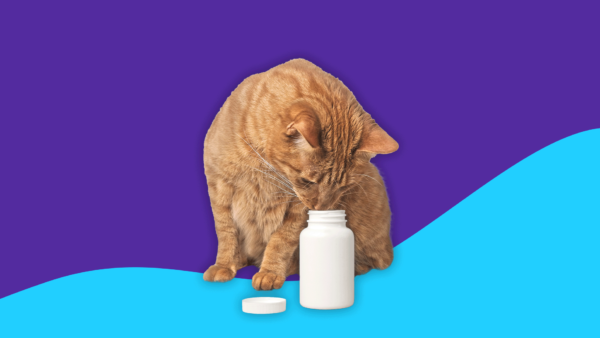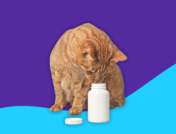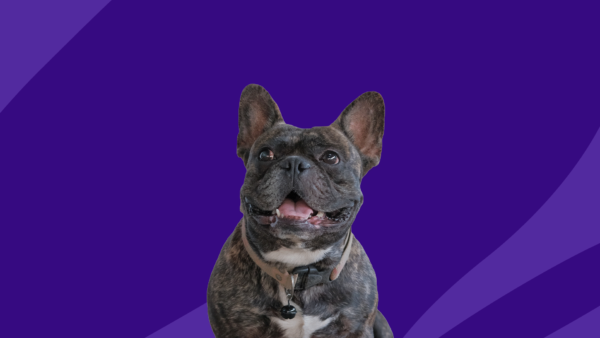Key takeaways
Methocarbamol is used to treat dogs with muscle pain or muscle spasms due to trauma, inflammation, spinal problems, or poisoning.
The standard methocarbamol dosage for dogs is 66–132 mg/kg per day if given by mouth, but intravenous injections have lower doses.
The most common side effects of methocarbamol in dogs are drowsiness, dizziness, and loss of coordination.
Methocarbamol should not be used in dogs that are allergic to methocarbamol.
Methocarbamol is a skeletal muscle relaxant prescribed to dogs to relieve muscle spasms and pain due to injuries, spinal disc problems, swelling, or poisoning. Methocarbamol works indirectly on the muscles by affecting the central nervous system. Because of the way it works, methocarbamol reduces muscle rigidity without affecting muscle tone, which is a problem with other muscle relaxants. The brand name version of methocarbamol is Robaxin, but for animals, this is only available as an injectable called Robaxin-V.
RELATED: Save up to 80% on methocarbamol
What is methocarbamol used for in dogs?
As a skeletal muscle relaxant, methocarbamol relieves muscle tremors, muscle spasms, and muscle pain in dogs due to injury, inflammation, intervertebral disc disease, or certain types of poisons.
Musculoskeletal injury
Veterinarians use injectable and oral methocarbamol for muscle pains and spasms due to injuries such as strains and sprains of the muscles or ligaments. Veterinarians also use it to calm muscle spasms before or after surgery and for spinal cord injuries.
Intervertebral disc disease
Spinal column discs are fibrous tissues that help keep the spine’s bones aligned and provide cushioning between the bones. These discs can degrade, stiffen with calcium, or get injured, causing pain and loss of movement. Called intervertebral disc disease (IVDD), disc problems are the most common cause of back pain in dogs. IVDD mainly affects a dog’s back. About 65% of dogs with IVDD have back problems, while only 18% have problems solely in the neck. Medications such as methocarbamol can be used to control pain in the early stages of IVDD, but surgery may be required at some point.
Poisoning
Methocarbamol is a drug of choice for treating strychnine poisoning, snail bait poisoning, and tetanus. It may also calm muscle tremors due to tremor-inducing fungal or guarana toxicity.
Strychnine is a common cause of dog poisoning. It is a powerful poison commonly found in rat or gopher bait. Though malicious poisoning is also common, these rodent baits contain food that attracts dogs, who dig them up and eat them. Dogs who eat a strychnine-laced product will experience muscle stiffness, tremors, and seizures, which veterinarians will treat with methocarbamol and other anticonvulsants.
Metaldehyde poisoning in dogs is rare. Metaldehyde is the toxin in snail bait, which is usually flavored with molasses or bran and attracts both snails and other animals, like pets. Shortly after a dog consumes metaldehyde, it will start twitching. This can worsen into severe twitching, seizures, and eventually death if the dog isn’t treated. Methocarbamol injections are a drug of choice to stop muscle spasms in a metaldehyde-poisoned dog.
Methocarbamol is also the primary treatment for muscle rigidity due to tetanus, a bacterial infection that produces a poison that affects the muscles. Finally, some fungus poisons and herbal supplements containing both guarana and ma huang can cause uncontrolled muscle tremors in a dog. Again, methocarbamol is a treatment of choice to calm these muscle problems.
Is methocarbamol safe for dogs?
The Food and Drug Administration (FDA) has approved methocarbamol as safe and effective for dogs. Like all drugs, it’s not 100% safe.
- Methocarbamol can never be safely used in any dog that has had an allergic reaction to the drug.
- Methocarbamol should be used with caution in pregnant or breastfeeding dogs.
- Because of its sedative effects, methocarbamol may not be safe for service dogs such as rescue dogs, police dogs, or guide dogs unless they’re relieved of their duties.
Side effects of methocarbamol in dogs
The most common side effects of methocarbamol in dogs are:
- Sedation (drowsiness, fatigue)
- Excess salivation or drooling
- Incoordination (ataxia)
- Weakness
- Vomiting
Some of these adverse effects can create safety issues. If a dog is stumbling, clumsy, or weak, ensure it’s put in a place where it can’t fall or knock over objects.
Some dogs on methocarbamol may have dark urine, but this should not be a cause for worry.
Other than possible allergic reactions, no serious adverse effects in dogs are associated with methocarbamol.
RELATED: Methocarbamol side effects and how to avoid them
Interactions of methocarbamol with other pet meds
Methocarbamol is a central nervous system depressant that slows down the brain. The drug interactions veterinarians are most concerned with involve drugs that also slow down the central nervous system. The combination could worsen the sedative effects of both medicines, creating safety concerns and possible health hazards such as respiratory depression. These drugs include:
- Opioid painkillers, such as tramadol
- Benzodiazepines, such as diazepam
- Selective serotonin reuptake inhibitors (SSRIs), such as Fluoxetine
- CBD (cannabinoid)
These drugs should only be combined with methocarbamol under the advice and care of a veterinarian. If a dog is taking CBD, discontinue its use until it is no longer taking methocarbamol.
If methocarbamol and another CNS depressant are being used at the same time, watch the dog carefully for excessive sedation or impairment. The dog may need to be confined or put in a place where it can’t fall or knock over objects.
The myasthenia gravis treatment, pyridostigmine, is another possible concern. Combining it with methocarbamol may make pyridostigmine ineffective and cause worsening symptoms of myasthenia gravis.
RELATED: Methocarbamol interactions to avoid
Methocarbamol dosage for dogs
Methocarbamol dosages depend on whether the drug is given by mouth or injected into a vein. The standard oral dose is 61–132 mg/kg per day divided into two or three daily doses. The standard IV dose is 44 mg/kg up to a maximum dose of 330 mg/kg.
Plumb’s Veterinary Drug Manual lists several methocarbamol dosages for different conditions:
- To relieve moderate conditions: 132 mg/kg taken by mouth each day but divided into doses taken every eight or twelve hours OR 44 mg/kg IV injection
- To treat muscle stiffness due to intervertebral disc disease: 15–20 mg/kg taken by mouth three times daily
- To treat severe effects of strychnine, tetanus, guarana, or tremorgenic fungal toxins: 55–220 mg/kg initial IV dose with follow-up IV doses as necessary
- To treat metaldehyde poisoning (snail bait poisoning): 50 mg/kg initial IV dose with follow-up IV doses as necessary
Can dogs overdose on methocarbamol?
Dogs can overdose on methocarbamol. It is a powerful muscle relaxant and CNS depressant, so an overdose is likely to cause side effects, particularly sedation and loss of coordination.
A methocarbamol overdose will likely make a dog sleepy, clumsy, and tired. It might drool or vomit. If these signs worsen or the dog shows signs of excessive sedation, then call an animal poison control center or bring the dog to a veterinarian or veterinary hospital.
The veterinary literature does not specify maximum dosages for oral methocarbamol, but injectable methocarbamol has a maximum veterinary dose of 330 mg/kg.
Can I give my dog methocarbamol every day?
Unless injected into a vein during an emergency, methocarbamol is not a one-shot drug. Pet parents will dose their dog two or three times a day with methocarbamol tablets or liquid. Treatment will last as long as needed, but it may be discontinued if it doesn’t work.
How to give your dog methocarbamol
When dogs need daily doses of methocarbamol, pet parents typically use methocarbamol tablets. If it’s too difficult to give your pet tablets, the veterinarian could prescribe methocarbamol liquid, specially prepared by a compounding pharmacy.
- Follow all the veterinarian’s instructions. Review the medicine’s prescription label to ensure you use the correct dose and dosing schedule.
- Give this medicine to the dog daily, every eight or 12 hours, depending on the veterinarian’s instructions.
- Give the dog methocarbamol for the total duration of the treatment.
- Methocarbamol can be given to a dog with a meal or on an empty stomach.
- If the dose causes nausea, vomiting, or other digestive system problems, try giving it to the dog with a meal or snack.
- If you don’t know how to give a dog a tablet, ask a veterinary technician at the vet’s office to demonstrate.
- If you give an oral suspension, shake the bottle before measuring a dose. Always measure the dose with an oral syringe. One should come with the medicine. If not, the veterinarian can provide one for free.
- If a dose is missed, give it when remembered. However, if it’s almost time for the next dose, skip the missed dose and give the next dose as scheduled.
- Ask the pharmacist for an approved pill minder container if skipped doses are problematic. The pharmacist may also suggest a reminder app or alarms that can help alert you to dosing times.
- Store methocarbamol tablets at room temperature and protect them from light.
- Keep this medicine out of the reach of children.
- The oral suspension may be flavored, so keep the medicine out of the reach of your pets.
Methocarbamol alternatives for dogs
Methocarbamol isn’t the only choice for treating muscle pain due to injuries, inflammation, and spine problems.
Instead of muscle relaxants, veterinarians often rely on anti-inflammatory and pain medications (NSAIDS) like carprofen or meloxicam. They are usually veterinarians’ first choice for treating muscle spasms due to injury, swelling, or other causes.
Corticosteroids like prednisone or prednisolone are also first-choice treatments, particularly for muscle pain associated with inflammation. These drugs don’t relieve pain or muscle spasms but reduce swelling and relieve pain that way.
Painkillers are another alternative. These include narcotic pain relievers like tramadol or buprenorphine, antidepressants, amantadine, or the nerve pain drug gabapentin.
Other alternatives include the muscle relaxants baclofen (for tetanus) and guaifenesin (for surgery).
Summary
When prescribed by a veterinarian, methocarbamol for dogs is safe and effective as an add-on treatment to relieve pain and muscle spasms in dogs. Follow the instructions and dosing schedule carefully. You may need to watch the dog for side effects such as drowsiness and poor coordination. Keep the dog in a safe place if it’s too drowsy or clumsy.
Sources
- Herbal supplements (toxicity), Merck Veterinary Manual
- Intervertebral disc disease at a glance, Clinician’s Brief
- Methocarbamol (Robaxin-V), Veterinary Partner
- Plumb’s Veterinary Drug Manual, 7th edition
- Methocarbamol, Plumb’s Veterinary Medication Guides
- Robaxin-V drug information, Pfizer
- Skeletal muscle relaxants, Merck Veterinary Manual
- Skeletal muscle relaxants for animals, Merck Veterinary Manual
- Snail bait poisoning in dogs, Veterinary Partner
- Strychnine toxicosis in animals, Merck Veterinary Manual
- Top 5 pain medications in clinical practice, Clinician’s Brief











